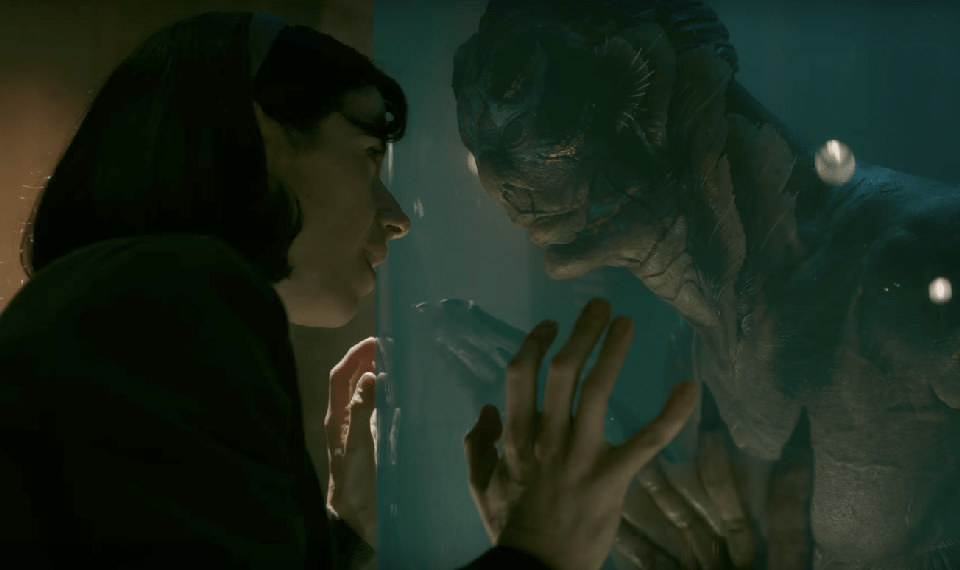Friday, 16 February 2018
Human flow: "The Shape of Water"
If at first you feel a touch queasy around The Shape of Water, the second most prominent beauty-and-the-beast romance of the past twelve months, that may be attributable to the colouring. Guillermo del Toro's lavish fantasy unfolds in a particular shade of aquamarine previously most associated with Jean-Pierre Jeunet's Amélie, the early 21st century's foremost Marmite movie - and here is another intensely art-designed study of loneliness centred on an entirely winsome heroine. (Jeunet has accused del Toro of plagiarising both from that film, and his earlier Delicatessen.) Is it, we might wonder, the interior decoration that scares potential suitors off? This jaded jade - like the roseate mud of del Toro's previous Crimson Peak - gets everywhere. It seems to have seeped into the walls of the Cold War-era Government research facility within which our mute heroine Elisa Esposito (Sally Hawkins) is employed as a lowly cleaner. It rhymes with the gills of the strange aquatic lifeform - half man, half fish - being held there under lock and key by the brutal, obsessive Strickland (Michael Shannon). Elisa's neighbour and confidante, a comparably sad and lonely middle-aged man called Giles (Richard Jenkins), bids for an illustrating gig with a mock-up ad featuring a housewife brandishing a vivid red Jell-O. "It needs to be green," comes the rejection. Of course it does.
In both its styling and its telling, this is a picture-book simple fable: a mutant Free Willy sequel, steered towards a race-against-time in which the creature will be spirited away from its vicious handlers and delivered back to the ocean. Yet it's bolstered by a slow-blossoming depth of characterisation that has yet to be observed anywhere in the Jeunet filmography. Before the creature shows up, del Toro and co-writer Vanessa Taylor sketch in nimble portraits of everyday solitude: it's here we find Elisa, letting her fingers do the talking and the walking, setting an egg to boil before taking her pleasure in the bathtub. (The makers of that old Cadbury's Flake advert might like to consider joining Jeunet in any class-action lawsuit.) The facility scenes, meanwhile, go towards a recognition of the precarious place occupied by the non-white, non-male humanoid in the Atomic Age workplace: the Latinate Elisa and her sister-in-cleaning supplies, the buoyant Zelda (Octavia Spencer), occupy the very lowest rung on the institutional ladder, there to mop and scrub at Strickland's say-so.
Yet the film is just as interested in the latter, bulking up the part from the one-dimensional caricature it might have been in other hands. So yes, evidently Strickland gets off on enforcing the kind of silence and complicity that have provided several dozen newspaper headlines of late, and his gangrenous fingers position him as an exemplar of literally toxic masculinity; but then del Toro and Taylor follow him home to his wife and kids, the better to observe how he behaves around people he's actually meant to care about. His colleague Dr. Robert Hofstettler (the suddenly resurgent Michael Stuhlbarg; and one of the film's connoisseurial pleasures is watching Stuhlbarg and Shannon circling one another) operates as a double agent, paid by the Russians to monitor developments at the American end. Some of these characters live dual lives; others lead no lives at all. The key - and the reason why, I think, this disarming fantasy has struck such a chord among early viewers - is that del Toro sees both the beauty and the potential for monstrousness in them all.
Among its many public services, The Shape of Water returns to the filmed fairytale that sex and violence that decades of Disney have trained out of filmmakers and audiences alike. del Toro and Taylor are not coy in depicting Elisa and the Creature's growing closeness: the two eventually get it on in a scene that squares the tenderness and lyricism of Cocteau's La Belle et la Bête with the headspinning WTF-ness of Borowczyk's La Bête, then pirouette through a black-and-white musical number à la Fred-and-Ginger (and, just perhaps, Young Frankenstein). Love or loathe them, it is a film of unusual - sometimes kinky - choices, revelling in the kind of authorial flourishes executives have been known to shout down or scrub out. All I'd say in the film's defence is that, just as that Jell-O had to be green, so too this is the only way these events could play out. For all its scaly, slimy peculiarities, this hybrid-movie emerges as a monument to del Toro's immense skill and fluency as a storyteller; he may now be Spielberg's only real rival in capturing viewer imagination. Shape sustains itself by a sense, forever true and often very moving, of which channels to follow, and where all this frothing motion (and emotion) must lead; the outcome is a film that couples idiosyncratic detail and excellence of craft with the satisfying inevitability of the best fables. That green, it turns out, is no index of stagnancy or sickness, rather that of a cinema in rude health: renewing and organic, and enchanted like a forest.
The Shape of Water opens in cinemas nationwide today.
Subscribe to:
Post Comments (Atom)

No comments:
Post a Comment